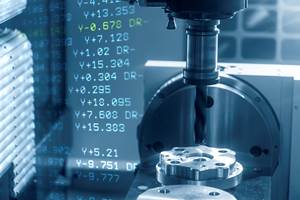Digital Twins Hand Moldmaker a Programming Edge
How can digital twins help solve a labor shortage? This tool and die shop uses digital twin technology to reverse engineer molds for glass bottles, making the process both faster and more reliable.
Share





As I write this article, I’m drinking water out of a glass mason jar. The jar has a threaded top with a flared lip below it, as well as raised numbers and lettering along each of its four rounded sides, plus some ornamental dots and ridges. Each of these features required someone to mill them into the mold that produced this jar I misuse as a drinking glass because my children have moved on from sippy cups and decimated the contents of my cabinet.
The minute details present on glass bottles creates difficult challenges for the specialists making and repairing the molds used to produce them. For Omega Enterprises, the challenge of accurately reproducing these features led to the company investing in digital twin technology to reduce the time spent reverse engineering the mold designs.
Source: All images provided by Hexagon
For Omega Enterprises — an Indiana tool-and-die shop specializing in repairing and reproducing molds for glass bottles — features such as these are an important part of its business. However, reverse engineering mold components is difficult work requiring careful measurements and skilled moldmakers. With the workforce being what it is, the company needed to keep its most skilled workers on profitable tasks, but the time it took to match the features to the tool path was keeping employees stuck in an engineering quagmire. To overcome this challenge, the company turned to digital twin and scanning technology from Hexagon.
Mold Repair and Glass Bottlenecks
Omega Enterprises began in 1993 in Winchester, Indiana. The company manufactures and repairs molds for the glass bottle industry, often having to reproduce complex artistic patterns for their customers. For a long time, reproducing these forms required tracing the parts with a touch probe in an older milling machine, a slow process for any bottle design. “A lot of what we do today is build and repair, or revisions,” says James Jarrett, president of Omega Enterprises. “When we have a job, we have to replicate whatever intricate glass design may be on those bottles.”
Digital twins have proved an invaluable tool in Omega’s workflow. With a digital twin, the company can precisely verify the accuracy of working models, taking the guesswork out of the process.
Even after nailing down the surface details, determining the approach to repairing the mold could be difficult. “We were constantly faced with altering molds and blanks with multiple compound angles that would require blending,” Jarrett says. This included molds that customers had altered by hand, requiring Omega to repair those features by hand as well. “It was challenging to try and reverse engineer exactly what had been done by hand. It was a lot of math combined with guesswork,” he continues.
The length of this process created a production bottleneck that drained time from valuable employees the company would prefer move on to higher-value work. “The biggest challenge we face, especially as a small business, is the labor shortage in manufacturing today,” Jarrett says. “We used to have 60 employees a decade ago, and now we’re down to 15, and we’ve lost a lot of skills those retired employees used to have.” Those skilled employees left have a lot of products on their plates, so any time saved is vital for the company.
The company searched for a way to speed the process of reverse-engineering and repairing molds, and it found the solution in digital twin technology.
First Pass Scanning Glass
While Omega Enterprises had already been using EdgeCAM for its machining processes, the company updated to the latest version to take advantage of its ability to build digital twin models from CAD and 3D scan data. “EdgeCAM allows operators to build a model from CAD or from 3D
scan data and maintain the integrity of the design,” says Chris Delwiche, manager at Hexagon Manufacturing Intelligence. “It uses automatic feature recognition to interrogate the model geometry and identify machinable features.”
The PrimeScan 3D scanner generates a digital twin that it uploads directly to EdgeCAM, enabling the programmers to quickly get to work. This dramatically reduces the time it takes to reproduce the features required by the company’s customers.
Using a PrimeScan 3D scanner — also from Hexagon — Omega Enterprises could quickly create a 3D model of the bottle features without the time-consuming manual process they had relied on earlier. Instead, the user simply points the scanner at a bottle and scans its vital features in a matter of minutes. The scanner generates a 3D replica and sends the STL file directly to EdgeCAM, where the user can get to work on tool paths. “Now that we can create a 3D scan using our PrimeScan scanner, the digital twin gives us an idea of exactly how the original mold was made,” Jarrett says. “We can easily adjust, measure, add overlays and even build new models.”
The accuracy of the digital twin and the ease of making adjustments are both valuable to the work of replicating mold designs. The company has to take into account many factors: ensuring the bottle holds the exact advertised volume of liquid, replicating the glass weight, avoiding sharp edges and replicating artistic decorations, among other things. “The digital twin helps us, as we can program a model and then take a 3D scan of the actual bottle and overlay that to make sure our model is a good match,” Jarrett continues. “We don’t need to guess anymore. It’s a huge advantage for what we do. We can even share the new models we make with customers.”
Additionally, the integration with EdgeCAM makes programming tool paths much easier, according to Jarrett. “Having the ability to produce a
super clean, high-quality 3D scan ensures we generate clean G code for our tool paths,” he explains. “EdgeCAM Strategy Manager provides machining strategies tailored to the manufacturer’s preferences and best practices,” Delwiche says. “It can create rules governing how a part will be
machined and reduce programming time.”
The accuracy of the digital twin produced using the 3D scanner enables the programmers to generate usable tool paths more rapidly. Vitally, the system also enables the programmers to work more closely with shopfloor personnel, despite being remote.
The digital twin produced by the 3D scanner also enables the shop’s programmers to work from home. “Ever since COVID, more and more people want to work remotely,” Jarret says. “We have two programmers and both of them work remotely — they aren’t located near our facilities at all. It’s hard to find a talented programmer, and technology like EdgeCAM makes it possible for our programmers to work remotely.” When questions arise, someone at the company’s main facility can scan the part and send a copy of the digital twin to the programmer so everyone knows exactly what the part looks like. Conversations about spacing between features, for example, are greatly improved when using an accurate 3D scan. This creates a foundation for clear communication, even across language barriers. “One of our programmers is based in Columbia,” Jarret says, “so the digital twin even helps with the language barrier. It's easier to explain things when we can quickly spin up a replica of the physical part using our 3D scanner.”
Digital Twins and Labor Wins
The scanner also reduced the time it took to move to the machining phase. Delwiche points to this as a major benefit for digital twins and 3D scanning. “The biggest value is to supplement the workforce,” he says. With fewer people entering the manufacturing labor force and many skilled workers retiring, knowledge is being lost. “The legacy knowledge isn’t there with newer hires, and there isn’t as much time to train people,” he continues, “so the more we can create technology that does the lion's share of the programming itself, or predicts the best way to run based on past use cases, the better.”
Jarrett agrees. “Given how hard it is to compete in manufacturing today, the only way to succeed is to take advantage of the technology we have in the States,” he says. “We need to rely on automation and the machines themselves being more intelligent.” In this case, using the 3D scanner and EdgeCAM halved the time it took to produce a finished mold. “Take a basket weave part,” Jarrett says. “It took 40 hours to duplicate the part in our previous process. Now we are able to do all that and cut parts within half that time.” That frees up a lot of time for valuable employees to move on to other projects. “We can get more control and be more precise, but most importantly, it saves us time and frees up our staff for other critical tasks.”
Related Content
Can AI Replace Programmers? Writers Face a Similar Question
The answer is the same in both cases. Artificial intelligence performs sophisticated tasks, but falls short of delivering on the fullness of what the work entails.
Read MoreTips for Designing CNC Programs That Help Operators
The way a G-code program is formatted directly affects the productivity of the CNC people who use them. Design CNC programs that make CNC setup people and operators’ jobs easier.
Read MoreHow this Job Shop Grew Capacity Without Expanding Footprint
This shop relies on digital solutions to grow their manufacturing business. With this approach, W.A. Pfeiffer has achieved seamless end-to-end connectivity, shorter lead times and increased throughput.
Read More2 Secondary Coordinate Systems You Should Know
Coordinate systems tell a CNC machine where to position the cutting tool during the program’s execution for any purpose that requires the cutting tool to move.
Read MoreRead Next
AMRs Are Moving Into Manufacturing: Considerations for Implementation
AMRs can provide a flexible, easy-to-use automation platform so long as manufacturers choose a suitable task and prepare their facilities.
Read MoreDigital Twin Provides Real-Time Feedback on Part Quality
By gathering data directly from the sensors of the CNC machine, the digital twin offered by Gemineering can identify whether a part is in tolerance and even identify the moment in the toolpath when a part fails to achieve tolerance.
Read MoreLast Chance! 2025 Top Shops Benchmarking Survey Still Open Through April 30
Don’t miss out! 91ÊÓƵÍøÕ¾ÎÛ's Top Shops Benchmarking Survey is still open — but not for long. This is your last chance to a receive free, customized benchmarking report that includes actionable feedback across several shopfloor and business metrics.
Read More






















